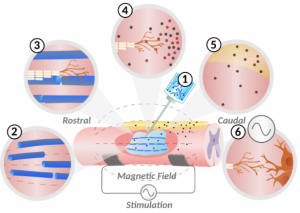Currently, 27 million people worldwide are affected by a spinal cord injury (SCI). In Canada, an SCI will cost $1.5 to 5 million per person over their lifetime. With the significant amount of SCI’s and the cost associated with this traumatic event has researchers eager to find a cure, but there has not been a successful solution so far. However, UBC researchers think they may have found a potential solution.
What is a Spinal Cord Injury?
The spinal cord is a column of nerves that runs down the middle of your back. It functions to carry sensory information from your body to your brain, motor signals from your brain to your body and controls one’s reflex responses. The spinal cord is an essential part of the human body and allows us to sense and interact with our surrounding environment. Therefore, it can have profound implications when the spinal cord gets injured. The most common cause for SCI’s is from trauma to the back, with the most common being motor vehicle accidents for younger individuals in the USA, and falls are the most common cause for individuals over 65 years. Over 50% of spinal cord injuries occur in individuals between the ages of 16-30 years, and most are males.

Description: Statistics associated with spinal cord injuries Source: https://mendthegap.ubc.ca/approach/
Exciting New UBC Research
Description/Source: Project Video By UBC Applied Science
UBC researchers just received a $24 million grant for their “Mend the Gap” project working on spinal cord regeneration. The research aims to use a soft gel containing small magnetic filaments that will help guide and reconnect or regrowth the nerves damaged in the spinal cord. “Mend the Gap” has had success doing this in a petri dish and is now working on how this concept can be applied to the human body in a non-invasive way. With the gel being soft, it can mend to different sizes and shapes of gaps in the spinal cord in a non-invasive way preventing further damage to the spinal cord. This gel will also contain medication that can help reduce scar tissue that will help with the regeneration process. The UBC scientist Dr. John Madden leads this project and works with engineers and researchers from Canada, the United States, Europe and Australia. Within Canada, ICORD, UBC, the University of Alberta, the University of Western Ontario, McGill University and the University of Toronto are all involved. The projects have 32 researchers from many disciplines, including electrical engineers, material chemists, microbiologists, neurobiologists, and neurosurgeons. “Mend the Gap” is hoping the project will be complete in 7 years from now. Dr. Madden hopes that their research will provide hope for SCI’s and potentially a cure.

The proposed method for spinal cord repair Source: https://mendthegap.ubc.ca/approach/
Ultimately, SCI’s have many consequences that affect many aspects of an individual’s life. UBC researchers’ new approach to fixing injured spinal cords can hopefully help people with spinal cord injuries gain independence. In the meantime, this research provides hope for the future of spinal cord injury research.
